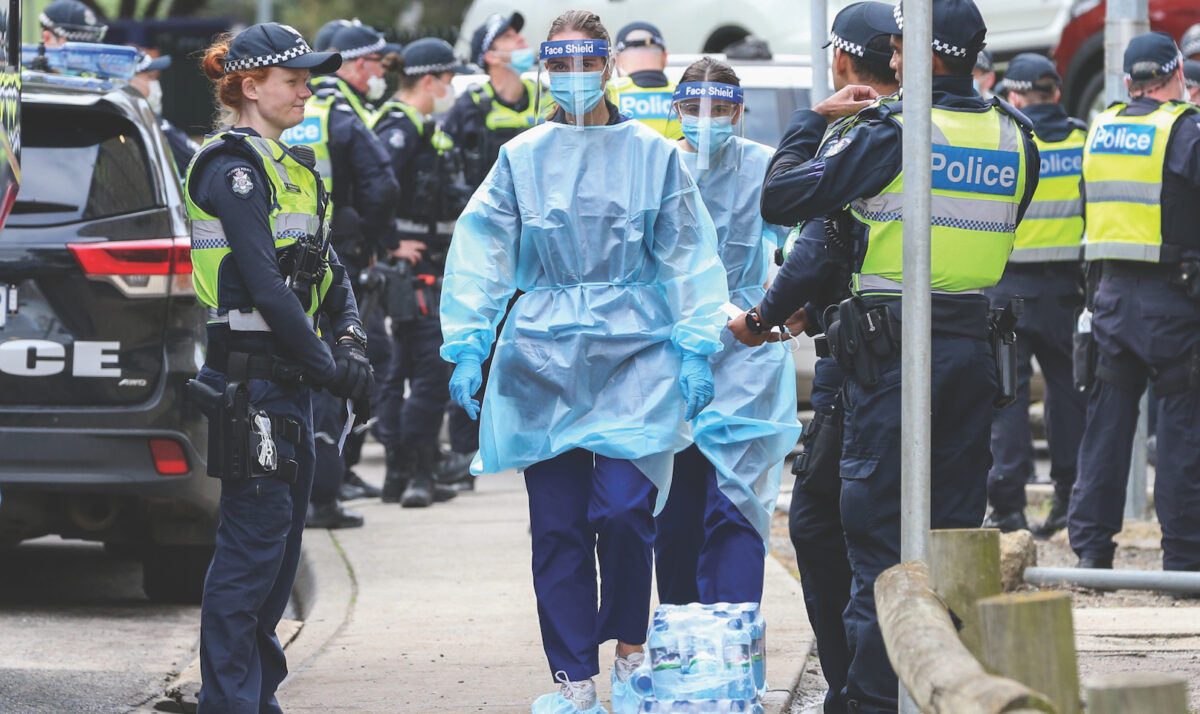Ageing Asia interviews industry leaders Stephen Muggleton, Patricia Sparrow and Arthur Koumoukelis to find out their views on COVID-19 vaccination strategy and their forecast of what a new normal will look like for the sector in Australia.
With the Therapeutic Goods Administration (TGA) investigation outcomes revealing no specific risk of COVID-19 vaccinations in seniors, vaccinations will be underway in February, prioritising seniors and aged care workers in Australia. Prime Minister Scott Morrison has also announced that residents and workers in aged care facilities will not be required to get a COVID-19 vaccination in order to remain living or working there, but does not rule out a future possibility of making a COVID-19 vaccine compulsory for aged care workers in the future.
In contrast to the rest of the world, Australia has taken a cautious “wait and see” approach as it observes global responses towards the vaccine. With adequate access to stocks of the vaccine, Australia plans to start their immunisation programme from February and to complete the roll out to the entire population by October. Australia will have access to 50 million doses of vaccines, enough to support two jabs for Australia’s population and Pacific countries.
While Australia is now returning to something that resembles a normal way of life, it's likely that nothing will be completely normal again until the COVID-19 vaccine has been widely rolled out. The Australian Government recently released its COVID-19 vaccination protocols and ACSA was glad to see that aged care workers and residents have been prioritised for vaccine access and are in the first group of Australians to get vaccinated, and elderly Australians living in their own homes are in the second group.
Australia’s vaccination strategy for seniors
Adjunct Professor Stephen Muggleton, Group CEO of Bolton Clarke shared, as at January 27, Australia has had 28,786 cases of COVID-19 with 909 deaths. 678 of those deaths took place in nursing homes during outbreaks in Melbourne and in Sydney.
One year on from the first case in Australia, a proactive national response and suppression measures including hard border closures, strategic lockdowns and compulsory quarantine and testing for people travelling from identified hot spots have helped keep numbers down. It is important to remember our dedicated and hard-working health and aged care workers who have been at the frontline of implementing this approach, which has helped us to maintain relative freedom compared with restrictions elsewhere globally.
The Therapeutic Goods Administration (TGA) has now approved the Pfizer vaccine, with the AstraZeneca vaccine on track for approval in February. In January, the Australian Government announced the vaccines would be rolled out across several phases, prioritising vulnerable people, including aged care residents and seniors.
The first phase roll out in February to March will include 1.4 million doses to those in quarantine, health care and aged care employees and aged care residents. The plans stop short of mandating the vaccine as compulsory for frontline aged care workers, which leaves state governments and providers to determine the best approach to protect clients, residents and employees. An additional challenge is ensuring access to the vaccines for remote vulnerable communities.
From March to April around a further 15 million doses will be given to 3 million people aged over 70 as well as other high-risk groups. Phase two will take in the remainder of the adult population (about 16 million doses) and phase three around 14 million doses to people under 18, if recommended.
How will operators change the way they manage aged care facilities of the future?
Sharing by Professor Stephen Muggleton, Group CEO, Bolton Clarke.
Within Bolton Clarke senior living communities our residents are currently enjoying normal activities including outings, group events and hosting visitors using COVID-safe practices. When community transmission is detected, health authorities have mandated protective measures in hot spots, including temporary aged care visitor restrictions. At these times, new technology has played a vital role in maintaining family and social connections. As we move into 2021, I would expect we will continue to see this kind of targeted local and rapid response for much of this year.
Strong clinical and corporate governance with established systems and processes backed up by research and deep expertise are critical for an early and effective response. Our early assessments of risk led to development of a four-part response plan with one purpose – protecting our teams, clients, residents and the broader community. This led to enhanced resident protection measures implemented from March including decontamination of incoming goods, increased cleaning measures and screening of all visitors, employees and contractors at single points of entry at each of our 25 residential aged care and 25 retirement living communities. Nationally Bolton Clarke completed more than 521,000 screenings across all sites and services throughout last year.

Given social distancing and other safety measures, our residential aged care and home care teams also proactively found new ways to help communities stay healthy, connected and active. We produced a series of new online health and wellness videos and developed new tracing and clinical reporting apps to ensure we could monitor clinical measures in real time. We also translated COVID-19 information and resources into 25 languages to support the needs of diverse communities.
In response to the crisis our teams providing community and in-home care have done exceptional work, making more than 541,000 client visits over a six-month period and taking on new roles supporting local communities, particularly through the extended restrictions in Melbourne. This included supporting community testing through the Victorian Government’s call-to-test response, providing COVID-19 testing for people who are housebound.
What are the lessons learnt from COVID-19 on the future of infectious disease outbreaks for the ageing population?
Sharing by Ms Patricia Sparrow, CEO, Aged & Community Services (ACSA), Australia
The biggest and most obvious lesson is that in the event of another major outbreak of COVID-19, or a different highly infectious disease, we must protect our elderly and most vulnerable as a matter of priority. Unfortunately deaths of older people in residential aged care have been far too common all around the world and we need to ensure that does not happen again. For a majority of 2020, ACSA advocated that the first aged care residents to test positive in any facility should be immediately relocated to hospital both for their own health and to protect the rest of the residents and workers in that facility.

Aged care homes are not set up to deal with infectious diseases the way hospitals are and we shouldn’t expect them to act like hospitals even during a crisis. COVID-19 highlighted that the interface between aged care and the health system doesn’t work as well as it should and needs to be a focus right now to help us to prevent deaths in any pandemic.
The importance of community and supporting each other, and those elderly people in the community, also came to the fore. It’s a change we hope will be permanent and work to increase the respect for older Australians across the board.
Raising the top questions on legal implications of COVID-19 vaccines for operators, staff, residents and visitors
Sharing by Mr Arthur Koumoukelis, Partner, THOMSON GEER, Australia
The COVID 19 vaccine is a remarkable breakthrough, but raises simple but difficult questions for all aged care providers as to whether vaccination should or can be mandated. But the question may not be mandating vaccination but rather mandating actions within aged care premises. The decision to vaccinate is a tension between an individual choice to be exposed to the disease and the efforts (and powers) of a provider to limit its transmission within a care service.
Compulsory vaccination in aged care can relate to:
- Staff – as a condition of working in the care service;
- Residents – For their own protection but who may refuse the vaccine as a personal choice (ignoring issues of capacity); and
- Third parties attending the facility- families, suppliers, regulators – who may carry the disease.
In considering the options, providers need to understand and balance:
- Their general duty of care to residents, staff and visitors to provide safe premises and not be negligent given providers are aware of the risks of the disease;
- Their rights as occupiers of premises to set the ‘rules’ for people entering their premises;
- Statutory duties to provide appropriate care to residents;
- Obligations to staff under employment contracts and awards; and
- Regulatory directives including public health orders

In Australia, public health orders require visitors to have been given a flu vaccination but no similar order exists for the COVID vaccine. As recently as 29 January the Federal Government has said the vaccine will not be compulsory for staff but will be ‘encouraged’.
In managing a care service, providers need to understand what the vaccine do. Based on current literature, vaccines:
- stop the disease but do not stop ongoing infection;
- a sufficient number of vaccinated persons will provide some herd immunity; and
- require the current actions of masks, washing hands and social distance to continue.
The experience of Newmarch House and other services is that if the disease enters a care service, it will likely spread and cause significant damage. Compulsory vaccination of a care service cohort may develop an internal ‘herd immunity’ and will protect vaccinated people from the disease.
Ultimately, the question of mandating vaccination may be misplaced and the question may be what limitations (if any) can be placed on non vaccinated persons to enter and remain on aged care premises where the risk of infection and transmission is heightened.


